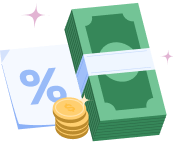Table of Contents
Credit card debt is a silent weight that millions of people carry. It can creep up quietly—one dinner out, one emergency car repair, one holiday splurge at a time—until suddenly, the minimum payments feel overwhelming and the interest keeps piling up. If you’re reading this, you’re already taking the first step toward freedom: getting informed and ready to act. Let’s walk through innovative, actionable strategies to pay off credit card debt faster, with the help of platforms like Beem to keep you on track.
Assess Your Credit Card Debt and Credit Health
List and Organize All Credit Card Balances
The journey to becoming debt-free starts with clarity. Before tackling your debt, you must know precisely what you’re up against.
- Gather all your credit card statements. Write down each card’s balance, interest rate (APR), and minimum payment.
- Create a simple spreadsheet or use a debt-tracking app. This visual overview will serve as your starting line and help you prioritize which debts to attack first.
Use Beem’s Credit Monitoring to Analyze Your Credit Profile
Understanding your overall credit health is just as important as knowing your balances. Beem’s Credit Monitoring tool gives you a real-time snapshot of your credit score, credit utilization, and any risk factors affecting your profile.
- Review your credit utilization ratio: This is the percentage of your available credit that you’re using. High utilization can drag down your score and make borrowing more expensive.
- Spot errors or fraudulent activity: Regular monitoring ensures you catch mistakes or suspicious charges early.
- Set payoff targets: Use your credit report insights to set realistic goals, like reducing utilization below 30% or boosting your score by a specific number of points.
Set Clear, Achievable Debt-Free Goals
It’s not enough to say, “I want to pay off my debt.” Make your goal specific and time-bound.
- Example: “I will pay off $5,000 in credit card debt in 18 months.”
- Break it into milestones: Monthly or quarterly targets will keep you motivated and on track.
Read related blog: How to Create a Debt Payoff Plan That Works
Build a Debt-Focused Budget
Track Your Income and Expenses
You can’t pay off debt faster if you don’t know where your money is going. Start by tracking every dollar you earn and spend for at least one month.
- List all sources of income: Salary, side gigs, passive income, etc.
- Categorize your expenses into three categories: Essentials (rent, groceries, utilities), minimum debt payments, and discretionary spending (dining out, entertainment).
Use Beem Budget Planner to Allocate More Toward Debt
Beem’s Budget Planner is designed to help you visualize your cash flow and make smarter decisions.
- Set up custom categories: Allocate more funds toward credit card payments.
- See your progress in real time: Beem’s visual dashboards show how much you’ve paid down and how much is left to go.
- Identify spending leaks: The planner highlights areas where you can cut back and redirect funds to debt repayment.
Cut Discretionary Spending and Redirect Savings
Every dollar counts when you pay off your debt. Look for “quick wins”—expenses you can reduce or eliminate without sacrificing your quality of life.
- Pack lunch instead of eating out.
- Cancel unused subscriptions.
- Pause non-essential shopping.
Redirect these savings directly to your highest-priority debt.
Read related blog: Should You Use a 401(k) Loan to Pay Off Credit Card Debt?
Choose the Right Debt Repayment Strategy
Debt Avalanche Method (Pay Off High-Interest Debt First)
The avalanche method saves you the most money in the long run.
- How it works: Make minimum payments on all cards, then put any extra money toward the card with the highest interest rate.
- Why it works: You’ll pay less interest overall, saving more money.
Debt Snowball Method (Quick Wins by Paying Off Smallest Balances)
If you need motivation, the snowball method offers psychological rewards.
- How it works: Pay off your smallest balance first while making minimum payments on the rest. Once that card is paid off, roll its payment into the next smallest balance.
- Why it works: Small victories keep you motivated and build momentum.
Hybrid or Personalized Approach
You don’t have to stick strictly to one method. Maybe you start with a snowball for motivation, then switch to an avalanche for maximum savings. Beem’s Budget Planner can help you simulate different approaches to see what works best for your situation.
Read related blog: Pay Off Debt With Beem’s Personal Loans to Boost Your Credit Score
Pay More Than the Minimum and Accelerate Payments
The Pitfalls of Minimum Payments
Credit card companies love minimum payments because they keep you in debt longer and maximize their interest earnings. If you only pay the minimum, paying off even a modest balance could take decades.
- Example: On a $5,000 balance at 18% APR, a $100 minimum payment could keep you in debt for years and cost thousands in interest.
Make Extra or Multiple Payments Each Month
Every extra dollar you pay goes directly toward your principal, not interest.
- Split your payments: If you get paid biweekly, make a payment each time you get paid.
- Round up payments: If your minimum is $110, pay $150 or $200 instead.
Apply Windfalls, Bonuses, or Tax Refunds to Debt
Got a work bonus, tax refund, or birthday cash? Instead of spending it, make a lump-sum payment on your highest-interest card. These “debt sprints” can shave months or years off your payoff timeline.
Read related blog: Can You Pay Off A Personal Loan Early?
Automate and Optimize Your Repayment Process
Set Up Automatic Payments with Beem’s Tools
Missing a payment can mean late fees and a hit to your credit score. Automation is your friend.
- Use Beem to schedule automatic payments for at least the minimum amount, ensuring you never miss a due date.
- Set up recurring transfers for extra payments if your budget allows.
Use Beem’s Reminders and Alerts
Life gets busy. Beem’s reminders and alerts help you stay on top of payment deadlines and celebrate progress milestones.
- Get notified before due dates so you can double-check your balance.
- Receive alerts when you hit a debt milestone or your credit score improves.
Pause New Credit Card Spending
Commit to a Cash-Only or Debit Lifestyle During Repayment
Digging out of a hole is tough if you keep adding dirt. While focusing on paying down debt, switch to cash or debit for all purchases.
- Leave your credit cards at home.
- Use Beem’s spending tracker to monitor your cash and debit purchases.
Remove Card Details from Online Accounts
Impulse purchases are easier when your card is saved on every shopping site.
- Delete saved card info from online retailers and apps.
- Unsubscribe from promotional emails that tempt you to spend.
Read related blog: The Impact of Medical Debt on Your Credit Score
Explore Debt Consolidation and Refinancing Options
Balance Transfer Credit Cards
If you have good credit, a balance transfer card with a 0% intro APR can save you hundreds in interest.
- Transfer your high-interest balances to the new card and pay them off before the promotional rate expires.
- Watch for transfer fees (usually 3–5%) and make sure you can pay off the balance in time.
Debt Consolidation Loans
A personal loan with a lower interest rate can combine multiple credit card balances into one fixed monthly payment.
- Shop around for the best rates.
- Use Beem’s Budget Planner to see if the new payment fits your budget.
EMI Conversion or Personal Loans
Some banks let you convert large credit card purchases into fixed monthly installments (EMIs) at a lower rate.
- Contact your issuer to see if you qualify.
- Compare the total cost to other consolidation options.
Read related blog: Steps to Take If You’re Struggling With Multiple Debts
Leverage Beem’s Credit Monitoring for Smarter Repayment
Track Improvements in Your Credit Score
As you pay down debt, your credit utilization drops, and your score should rise. Beem’s Credit Monitoring lets you see these changes in real time.
- Watch your progress: Celebrate every point increase as a sign you’re moving in the right direction.
- Understand the impact: See how specific actions—like when you pay off a card—affect your score.
Get Personalized Alerts and Insights
Beem doesn’t just monitor your score; it gives you actionable tips.
- Get alerts for credit changes: Be notified if your utilization spikes or if there’s suspicious activity.
- Receive tailored suggestions: Beem can recommend steps to boost your score further or avoid pitfalls.
Seek Professional Support If Needed
Negotiate with Creditors for Better Terms
If you’re struggling, don’t wait until you miss payments. Many creditors are willing to work with you.
- Request a lower interest rate: A simple phone call can reduce your APR.
- Ask about hardship programs: These may offer temporary relief or modified payment plans.
Consult a Credit Counselor or Financial Advisor
A nonprofit credit counselor can help you create a debt management plan if your debt feels unmanageable. For more complex situations, a financial advisor can provide personalized guidance. Look for accredited agencies through the National Foundation for Credit Counseling (NFCC).
Read related blog: Tips for Paying Off Student Loans: Millennial Tips
Monitor Progress and Stay Motivated
Celebrate Debt Payoff Milestones
Paying off debt is a marathon, not a sprint. Celebrate each victory—paying off a card, reaching a new credit score tier, or hitting a savings goal.
- Treat yourself to a small, budget-friendly reward.
- Share your progress with friends or in online communities for extra encouragement.
Adjust Your Plan as Life Changes
Life is unpredictable. If your income changes or you face new expenses, revisit your budget and adjust your repayment plan.
- Be flexible and forgiving: Progress, not perfection, is the goal.
Use Beem’s Visual Tools to Track Progress
Beem’s dashboards make it easy to see how far you’ve come.
- Visualize your debt reduction: Graphs and charts keep you motivated.
- Set new goals: Once debt-free, use Beem to plan for savings, investments, or other financial milestones.
Read related blog: How to Get a Credit Card With No Credit History: Experts Guide
Build Lasting Financial Habits for a Debt-Free Future
Start an Emergency Fund
One of the main reasons people fall into credit card debt is unexpected expenses. An emergency fund is your first line of defense.
- Aim for at least $500–$1,000 to start, then work up to 3–6 months of expenses.
- Automate savings with Beem’s budgeting tools.
Practice Mindful Spending and Responsible Credit Use
Once you’re debt-free, the goal is to stay that way.
- Review your budget regularly: Use Beem to align your spending with your values.
- Use credit cards strategically: Pay monthly to build credit without paying interest.
- Continue monitoring your credit: Early detection of problems keeps you in control.
Read related blog: How Much Should I Pay for My Credit Card? Explore Solutions
Conclusion
Paying off credit card debt faster isn’t just about numbers—it’s about reclaiming your peace of mind and building a foundation for a brighter financial future. By assessing your debt, creating a focused budget, choosing the right repayment strategy, and leveraging tools like Beem’s Credit Monitoring and Budget Planner, you can break free from the cycle of debt and unlock new possibilities.
Remember, every step you take—no matter how small—brings you closer to financial freedom. Start today, stay consistent, and let Beem be your partner on the journey to a debt-free life. Download the app now!
















































